Home safety
Home safety
Title: Home Safety
Narrator: Home safety.
Photo: A girl (12 – 18 months old) is bringing some toys to her dad.
Photo: A boy (12 – 18 months old) is running in the living room while his parents are looking at him.
Photo: A boy (18 – 24 months old) is climbing up the sofa
Photo: A girl (18 – 24 months old) is pulling the curtain ropes
Narrator: Your energetic child loves to run and jump around! However, he has no idea of any danger around him. You should stay alert and check home safety measures regularly so as to prevent any possible accidents.
Heading: Ensuring Your Child's Safety
Narrator: Ensuring your child's safety.
Sub-heading: Don't leave your child alone at home
Photo: Daddy is going out, his son (5 years old) and daughter (3 years old) are saying goodbye to him. Big cross.
Photo: Daddy is going out, Mum, his son (5 years old) and daughter (3 years old) are saying goodbye to him.
Narrator: To ensure safety, don't leave your children alone at home or to the care of older children. Remember, there should be an adult with them at all times.
Sub-heading: First-aid kit
Photo: First-aid Kit
Narrator: Keep a first-aid kit at home in case any minor accidents occur. It should include:
Sub-heading: Alcohol swabs
Photo: Alcohol swabs
Narrator: Alcohol swabs: for sterilising both hands before performing first-aid treatment.
Sub-heading: Gauze roller bandage
Photo: Gauze roller bandage
Sub-heading: Elastic roller bandage
Photo: Elastic roller bandage
Narrator: Gauze or elastic roller bandage: to bandage a wound and stop bleeding with applied pressure.
Sub-heading: Triangular bandage
Photo: Triangular bandage
Narrator: Triangular bandage: to wrap injured areas, support or fix broken limbs.
Sub-heading: Round-ended scissors
Photo: Round-ended scissors
Narrator: Round-ended scissors: to cut adhesive tape, bandages or clothing when necessary.
Sub-heading: Disinfectant
Photo: Disinfectant
Photo: Saline Solution
Narrator: Disinfectant: for disinfecting and cleaning wounds.
Sub-heading: Sterile dressing set
Photo: Sterile dressing set
Photo: An opened sterile dressing set
Narrator: Sterile dressing set: to clean and cover wounds.
Sub-heading: Sterile gauze pad
Photo: Sterile gauze pad
Sub-heading: Non-woven sterile gauze pad
Photo: Non-woven sterile gauze pad
Narrator: Sterile gauze pad: to cover wounds.
Sub-heading: Sterile adhesive bandage
Photo: Sterile adhesive bandage
Narrator: Sterile adhesive bandage: to cover small wounds.
Sub-heading: Plaster
Photo: Plaster
Narrator: Plaster: to fix a dressing
Sub-heading: Disposable gloves
Photo: Disposable gloves
Narrator: Also, disposable gloves
Sub-heading: 3-Ply surgical masks
Photo: 3-Ply Surgical masks
Narrator: and 3-ply surgical masks.
Photo: A girl (5 years old) cuts her finger and asks dad and Mum for help.
Photo: Mum puts on a bandage for her and the first-aid kit is next to her.
Narrator: You should equip yourselves with first-aid skills. When your child gets hurt, you may help your child with the materials in the first-aid kit and take him to the doctor if required. If it is serious, take your child to hospital promptly.
Heading: Living Room Safety
Narrator: Living room safety.
Photo: Living room
Narrator: Furniture in the living room may also cause injuries.
Sub-heading: Choose furniture without sharp edges
Photo: Round table
Narrator: Consider furniture without sharp edges as your first choice.
Sub-heading: Cover sharp edges with corner protectors
Photo: Table with corner protectors
Photo: Drawer with corner protectors
Narrator: If there are sharp edges on the furniture, cover them with corner protectors.
Photo: Glass surface. Big cross.
Photo: Tablecloth. Big cross.
Photo: Table mat. Big cross.
Narrator: You should avoid using furniture with fragile glass surfaces. Don't use tablecloths or table mats; everything will fall off if your child pulls on them.
Sub-heading: Use folding tables or chairs with safety lock
Photo: Folding Table
Photo: Safety lock of folding tables (1), (2)
Narrator: Avoid using folding tables or chairs unless they have a safety lock.
Sub-heading: No stacking
Photo: Plastic boxes are stacked up. Big cross
Photo: Short ladder. Big cross.
Narrator: Don't leave ladders around or stack items, so as to prevent children from climbing and falling down.
Sub-heading: Place sofas against the wall
Photo: A sofa is placed against the wall
Photo: A boy (18 – 24 months old) climbs onto the sofa. Big cross.
Narrator: Sofas should be placed against the wall, or else your child may climb over the back of the sofa and fall down.
Sub-heading: Add railings to balconies
Photo: A balcony with railings
Photo: Door to balcony is opened. Big cross.
Photo: Door to balcony is locked
Narrator: To ensure the safety of your child, balconies should have railings and the balcony doors should be locked at all times.
Sub-heading: Install and lock window guards
Photo: A window guard with a ruler
Photo: Window guards
Photo: Window guards which can be opened
Photo: A locked window guard (1)
Photo: A locked window guard (2)
Narrator: Install standard window guards on all windows. Remember, to keep the window guards locked at all times.
Sub-heading: Tie up curtain cords
Photo: Close-up of the tied-up curtain cords
Photo: A curtain cord
Photo: A girl (18 – 24 months old) is pulling the curtain cord. Big cross.
Narrator: Keep curtain cords out of your child's reach and remember to tie them up. Your child could be strangled and suffocated if her neck gets caught in the cords.
Sub-heading: Door stoppers
Photo: A door stopper fixes the position of a half-opened door
Sub-heading: Magnets
Photo: Magnet fixes the position of an opened door
Narrator: Stop opened doors from swinging with door stoppers or magnets.
Sub-heading: U-shaped door stoppers
Photo: A U-shaped door stopper prevents the door from shutting
Narrator: The U-shaped door stoppers can help protect your child's fingers from being pinched in the door.
Sub-heading: Socket protective covers
Photo: Socket is covered by a protective cover
Narrator: Use protective covers for sockets.
Sub-heading: Put away electric extension units
Photo: An electric extension unit is on top of a cupboard
Narrator: And keep electric extension units out of your child's reach.
Sub-heading: Put safety covers on electric fans
Photo: A safety cover is on an electric fan.
Photo: Close-up of the safety cover.
Narrator: There must be a safety cover on an electric fan.
Sub-heading: Keep the fan away from children's reach
Photo: An electric fan is on top of a cupboard
Narrator: Also, make sure that your child cannot reach the fan.
Sub-heading: Store matches and lighters properly
Photo: A box of matches and lighter
Photo: matches and lighter placed in a drawer
Narrator: Store matches and lighters properly in a drawer, out of the reach of children.
Sub-heading: Fasten seatbelts
Photo: A baby is sitting on the stroller, with the seatbelt fastened.
Photo: A baby is on the high-chair, with seatbelt fastened and locks secured.
Photo: The seatbelt is fastened.
Narrator: Fasten the seatbelt when your child is sitting in high chairs or strollers and secure the booster seat.
Sub-heading: Safe use of iron
Photo: Mum stops her son (5 years old) from approaching her when she is ironing clothes.
Narrator: Children should not be around when you are ironing. It is dangerous if your child touches it.
Photo: An iron is placed on an ironing board. Big cross.
Narrator: When you finish using an iron, don't leave it around. Put it away properly.
Sub-heading: Keep the house clean and tidy
Photo: Mum is tidying up the house.
Narrator: Keep your house clean and tidy. Don't scatter things around or your child may stumble over them.
Heading: Kitchen Safety
Narrator: Kitchen safety.
Photo: A messy kitchen. Big cross.
Photo: A tidy kitchen.
Narrator: A kitchen is also a place full of danger.
Sub-heading: Install a gate
Photo: A gate at the kitchen door
Photo: A boy (18 – 24 months old) is at the kitchen door gate.
Narrator: Install a gate at the kitchen door to prevent your child from entering the kitchen.
Photo: In the kitchen, Mum is carrying her baby. Big cross
Narrator: Also, don't carry your child in the kitchen. Children can reach out and grab things.
Sub-heading: Turn handles of cookware inward
Photo: The handle of cookware points outward on the stove. Big cross.
Photo: The handle of cookware points inward on the stove.
Narrator: The handles of cookware should point inward on the stove. It can prevent your child from tugging it and being scalded accidentally.
Sub-heading: Cover the stove
Photo: A stove is covered.
Narrator: If your stove has a cover, use it when the stove is not in use.
Sub-heading: Put away dangerous items
Photo: Knives and scissors are on the rack which is placed at a far corner on the kitchen counter.
Photo: Electric kettle is placed against the wall on the counter.
Photo: First-aid kit is put up high.
Photo: Detergents are put inside a cupboard.
Narrator: Put all dangerous items, including sharp utensils, medications, electric kettles, hot water flasks and detergents, out of the reach of your child.
Photo: Detergent is stored in soft drink bottle. Big cross.
Narrator: Don't use any drinking bottles to store detergents or other chemicals. It is dangerous if children mistake them as drinks!
Heading: Bathroom Safety
Narrator: Bathroom safety.
Photo: Tidy bathroom
Photo: Untidy bathroom.
Narrator: Take safety precautions in the bathroom too. It is full of traps.
Sub-heading: Keep bathroom door closed
Photo: Bathroom door is closed
Narrator: Always keep the bathroom door closed to prevent your child from entering the bathroom.
Sub-heading: Keep the toilet covered
Photo: Toilet cover is on
Narrator: Besides being hygienic, keeping the toilet covered can also prevent your child from sticking his head into the toilet bowl.
Sub-heading: Keep bathroom clean and dry
Photo: Water on bathroom floor. Big cross
Photo: A dry bathroom
Narrator: Keeping the bathroom dry can protect your child from slipping on the floor.
Sub-heading: Put an anti-slip mat in the bathtub
Photo: An anti-slip mat in the bathtub
Narrator: If you are using a bathtub, put an anti-slip mat inside.
Sub-heading: Put away containers with water
Photo: A bucket is placed on the bathroom floor. Big cross.
Narrator: Don't leave containers filled with water around. Children may drown if they fall into it.
Sub-heading: Use a plastic baby bath
Photo: Baby is bathing in a plastic baby bath
Narrator: Use a plastic bath to bathe your baby in the bath tub.
Photo: Mum is bathing her baby.
Narrator: Never leave your baby in the bath alone, even if it is just for a brief moment.
Sub-heading: Have all items ready
Photo: Mum has all the bathing items needed.
Narrator: Therefore, have all items ready for bathing beforehand.
Sub-heading: Always add cold water before hot water
Photo: Putting cold water into bath basin.
Narrator: When preparing a bath for your child, always put cold water in before hot water.
Sub-heading: Test water temperature with your elbow
Photo: Mum is testing water temperature with her elbow
Narrator: Then, test the water temperature with your elbow before bathing your baby.
Heading: Bedroom Safety
Narrator: Bedroom safety.
Photo: Bedroom (1)
Photo: Bedroom (2)
Narrator: Make sure your child has a safe sleeping environment to protect him from risks.
Sub-heading: Put the cot near your bed
Photo: A cot is next to the parents' bed
Narrator: If possible, let your baby sleep in his cot and put the cot next to your bed.
Sub-heading: Appropriate mattress size
Photo: The size of the mattress fits the size of the baby cot.
Narrator: The mattress should fit the size of the baby cot. If there is a gap, the baby's tiny head may get trapped and he may suffocate as a result. There should not be any soft objects or loosely tucked sheets on the bed. A baby can sleep well without a pillow.
Sub-heading: Lock the bars of the cot
Photo: A baby is sleeping in the cot with bars locked
Narrator: Make sure that the bars are locked to avoid your baby falling onto the floor when in the cot.
Sub-heading: Distance between vertical bars should not exceed 6cm
Photo: Showing the distance between the vertical bars is less than 6cm
Narrator: The distance between the vertical bars should not exceed 6 cm or 2.5 inches. Babies can stick out their heads and get stuck if the bars are too wide apart.
Sub-heading: Height of rails should be higher than 3/4 of your child's height
Photo: A toddler is standing in the cot
Photo: The height of the rails is no less than 3/4 of the height of the baby
Narrator: The height of the cot rails should be higher than 3/4 of your baby's height.
Photo: A baby is sitting on the sofa alone. Big cross.
Photo: A baby is alone on a bed without guards. Big cross.
Narrator: Never leave your baby alone on the sofa or bed without guards, even if it is just for a brief moment.
Photo: A curtain cord is close to the baby cot. Big cross.
Narrator: Make sure that the curtain cords are out of the reach of your child. Your child could be strangled and suffocated if her neck gets caught in it.
Photo: A bunk bed
Narrator: Be cautious if you have a bunk bed at home.
Sub-heading: Install a secure ladder
Photo: A secure ladder on the bunk bed.
Narrator: A secure ladder can prevent accidents.
Sub-heading: Use foam mats
Photo: A foam mat is placed near the bed
Photo: A foam mat
Narrator: You can also have added protection by placing foam mats on the floor.
Photo: A bunk bed with secure safety bars
Photo: A bunk bed is put against the wall
Narrator: The top bunk should be fitted with secure safety bars of an appropriate height.
Sub-heading: Place the bunk bed against the wall
Narrator: Don't leave a gap in between the bed and the wall because children may get themselves stuck.
Photo: Mum is talking to her son (2 years old) at the kitchen door with a gate in between them.
Narrator: Therefore, it is important to pay close attention to your children and give safety education to them when appropriate.
Photo: A family is reading storybook together.
Narrator: So please stay alert! Most injuries can be avoided when preventive measures are taken.
End Shot: Department of Health logo
The Department of Health owns the copyright of this digital video.
This digital video is produced solely for non-commercial use.
It should not be rented, sold or otherwise used for profit-making purposes.
Produced in 2015
Preventing Home Accidents
Children of 2-3 years old have higher mobility. They like to run, jump and climb around, as well as trying out difficult actions. However, there are many potential risks around and they do not understand the dangers. Accidents occur when parents are not aware of the risks, have not taken preventive measures or have left their children in hazards even briefly. Therefore, besides setting appropriate limits and educating your child about home safety, always be alert and check the safety measures at home regularly to prevent home accidents.
All You Need in Your First-aid Kit
Home accidents do happen. As children are dependent in protecting themselves, parents need to observe home safety precautions, as well as knowing how to handle accidental injuries at home. Parents should equip yourselves with first-aid skills in case of accidents, and prepare a first-aid kit at home to treat minor injuries. If the condition gets serious, consult a doctor as soon as possible.
A standard first-aid kit should contain:
- Sterilized cotton
- Sterilized gauze
- Dressing Pad
- Adhesive bandages
- Elastic bandage (5cm (2”) wide and 7.5cm (3″) wide each)
- 70% alcohol
- Mild disinfectant
- Safety pins
- Round-ended scissors
- Triangular bandage
- Disposable gloves
Eating
Besides providing adequate nutrients, a balanced diet can help your child develop good eating habit. As children grow up, their eating habit may change. Some even become a picky eater. Your patience is needed to foster good eating habit and healthy growth in your child.
Tips on Healthy Diet
The age period of 2 to 6 years is a crucial time for your child's growth and development. They use more thinking and language in learning and their eating habits are closer to those of adults. To be a good role model, it is important that you keep to a healthy diet.
How Much Should My Child Eat?
To ensure that your child takes in sufficient nutrients, you need to consider both the “quality” and “quantity” of food in order to have a balanced diet to meet the needs for your child's growth. The “Healthy Eating Food Pyramid” is your good guide! You can choose a variety of food from each food group according to the proportion.
Healthy Eating Food Pyramid for 2 to 5 Years Old
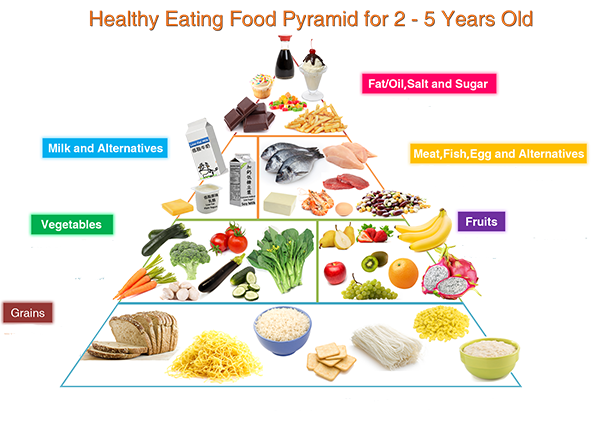
- Grains: eat the most. 1½ – 3 bowls of grains a day e.g.brown rice, wholemeal bread, pasta (1 bowl = 250 to 300ml)
- Vegetables: at least ¾ bowl of cooked vegetables each day
- Fruits: at least 1 medium-sized fruit such as orange or apple a day
- Meat, fish, egg and alternatives: 1½ to 3 taels of meat or fish daily (1 tael = size of a ping-pong ball)
- Milk and alternatives: 2 glasses per day (1 glass = 240 ml)
- Fat or oil, salts and sugar: eat the least
- Drink 4 to 5 glasses of fluid every day including water, milk, clear soup, etc
How Much Should Be Served for Each Meal?
Breakfast, lunch, dinner and snacks provide your child with the energy and nutrition needed. You may refer to the following:
- Breakfast 30%
- Lunch 30%
- Morning and afternoon snacks 10%
- Dinner 30%
Meal Arrangements to Fulfill Daily Calorie and Nutritional Needs
For main meals, you can provide your child with proper amounts of grains, vegetables and meat by following the “321” ratio.
Grains should make up half of a main meal since they are the main source of energy. Dishes comprise of mainly vegetables takes up one-third of a meal, with one-sixth being the fish, meat, eggs, beans and alternatives. Lean meat, fish and skinless poultry are good choices of meat. Choose water, soy milk with low sugar, low fat milk or pure natural fruit juice for drinks.
Keep in mind that food has to be of wide variety and fresh. Do not choose processed or fatty food for your child.

Healthy Snacks
Healthy snacks help to top up water and energy lost during activities and act as a supplementary source of nutrients. However, eating too much or unhealthy snacks would lead to excessive energy intake and result in overweight. It also reduces their appetite for main meals, which leads to insufficient nutrient intake and possible negative impact on health. Bear in mind principles of healthy eating when giving your child snacks, so that he can get the most benefits from healthy snacks.
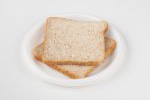



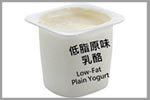
Make it a healthy and happy day for your child
Healthy eating habit, adequate rest and sufficient physical activities all are essential for children's healthy development. In addition, positive parent-child relationship makes you and your child enjoy every moment including meal time.
Example of Everyday Meals
*Tablespoon (tbsp) refers to Chinese tablespoon
Wake up and Brush Teeth
Take your child to his seat for breakfast after he is awake

Breakfast
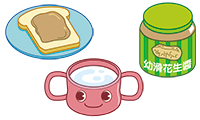
Meal items:
- Creamy Peanut Butter Toast
- 1 slice Bread and
- 1 teaspoon Peanut Butter
- 120ml Low fat milk
Tips:
- Eat with Dad and Mum
- Choose cream peanut butter to prevent choking by peanut chunks
- Don't let your child drink milk from bottle when he is not fully awake

Let your child play or have plenty of physical activities
This is good for appetite, development and health

Snack
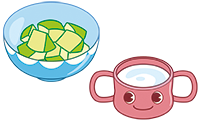
Meal items:
- 1/2 Pear
- 120ml Low fat milk
Tips:
- Your child is old enough to drink milk
and water from a cup -
Remember to make
using cup interesting

Lunch

Meal items:
- Homemade Sushi roll with cooked Tuna, Egg and Carrot
- 1/2 bowl white Rice
- 2 tbsps.* Tuna
- 1/2 Egg
- 2 tbsps.* Carrot (boiled and shredded)*
- 1 slice Nori
- Water

Afternoon Nap

Afternoon Snack
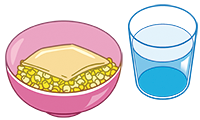
Meal items:
- 1/3 bowl boiled Corn Kernels with 1 slice of Cheese
- Water

Activities (Indoor / Outdoor)
Have more physical activities to replace sedentary ones
Bath time

Dinner
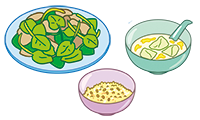
Meal items:
- Stir-fried Chinese Spinach with Beef
- 2 tbsps.* chopped Chinese Spinach
- 2 tbsps.* chopped Beef
- 1/2 bowl Hairy Cucumber Egg Soup
- 1/2 bowl Brown Rice
- Soak the brown rice for 2 hours before cooking with white rice
Tips:
- Establish good eating habit. Never feed your child when he is running around. Let him eat by himself
- Eat together with family
- Teach him to indicate he is full and let him leave his seat if he finishes his meal in 30 minutes

Quality Time
“Quality time” helps building good parent-child relationship with trust, making parenting easier

Evening Snack

Meal items:
- 3 Strawberries
- 90 ml Yoghurt
- Water
Tips:
- Teach your child to share fruits with family
- Sharing with others is enjoyable

Brush Teeth and Go to Bed
Regular daily routines and bedtime routine help your child sleep well
Example of Holiday Meals
*Tablespoon (tbsp) refers to Chinese tablespoon
Wake up and Brush Teeth
Take your child to his seat for breakfast after she is awake

Breakfast
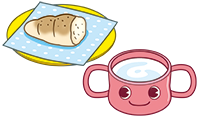
Meal items:
- 1/2 Plain roll/bun
- 120ml Low fat milk
Tips:
- Your child is old enough to drink milk
and water from a cup - Don't let your child drink milk from bottle when she is not fully awake

Let your child play or have plenty of physical activities
This is good for appetite, development and health

Snack

Meal items:
- 3-4 Grapes (Before going out, wash the grapes and put them into a box with lid)
- 120ml Low fat milk
Tips:
- Your child is old enough to drink milk from a cup
- Remember to make
using cup interesting

Lunch (Shanghainese Restaurant)
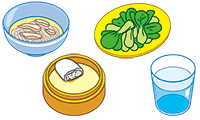
Meal items:
- Stewed noodles with chicken
- 2 tbsps* Chicken
- 1/3 bowl Shanghai noodles
- 1/3 Chinese steamed bun
- 3-4 stalks Baby Shanghai Greens in clear broth
- about 3 tbsps* after chopped
- Water

Afternoon Nap

Afternoon Snack
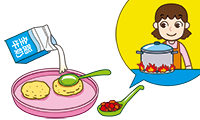
Meal items:
- Mashed Potato with Tomato
- 1 tbsp* chopped Tomato
- Mashed potato (2 egg-sized potatoes)
- Mix 60ml Low fat milk
Tips:
- Mum cooks Tomato Potato soup for dinner

Activities (Indoor / Outdoor)
More physical and outdoor activities to replace sedentary ones and to expand his scope of learning
Bath

Dinner
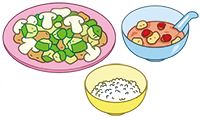
Meal items:
- Stir-fried Zucchini, Mushroom and Meat
- 3 tbsps* chopped Zucchini and Mushroom
- 2 tbsps* chopped Meat
- 1/2 bowl Tomato Potato Soup
- 1/2 bowl White rice
Tips:
- Establish good eating habit. Never feed your child when he is running around. Let him eat by himself
- Eat together with family
- Teach him to indicate he is full and let him leave his seat if he finishes his meal in 30 minutes

Playtime

Evening Snack

Meal items:
- Diced Dragon Fruit (about 1/4 bowl)
- 60ml Low fat milk (when needed)
Tips:
- By age 1, balanced diet with a variety of solid food replaces milk to be the main source of nutrients

Brush Teeth and Sleep
Regular daily and bedtime routine helps your child sleep well
What Can I Do with My Picky Eating Child?
Picky eating is common among little children. However, most of them grow out of the problem when you understand the reasons and help them appropriately. Your child needs your patience and modelling to help them get rid of picky eating.
Physical Activities
Children of 2 to 3 years old are very energetic. They enjoy running, jumping, and climbing around rather than slowing down. So do not expect your child to sit still all the time or restrict his activity. He will need space for physical activities from which he learns about his capabilities, his body structure and characteristics. Physical activities help to build up a healthy body.
- Children of 2 to 6 years old should have at least 3 hours of physical activities carried out in separate time slots every day.
- Bring your child to open areas like parks or playgrounds. Let him run and play to discharge his energy.
- When you go out, let your child walk on his own without staying in your arms or the stroller. Just stay close by your child to ensure his safety.
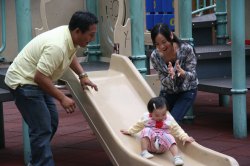

Avoiding Screen Time
From TV, video games, computers, smart phones to tablets, there is a wide variety of screen-media products nowadays. Many people consider screen-media learning an inevitable trend for children, and the earlier the better. However, “screen time” is mostly sedentary. Studies have shown that screen time is negatively associated with the well-being of children as it:
- Reduces the amount of physical activity children should have and leads to obesity
- Hinders motor and language development of children
- Leads to unhealthy eating habits
- Increases chances of children Imitating problem behaviours
- Affects sleep quality, attention, social and communication skills
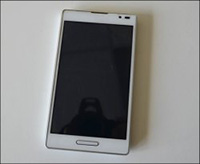

Therefore, you need to cut down screen time together with your child as a role model.
Recommendations of Sedentary and Screen-time:
- Limit the time accumulated for TV or computer games to within 1 hour
- Replace screen time with singing, dancing, physical play and parent-child activities.

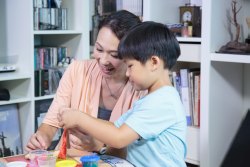
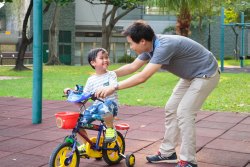
Tips:
- Be a role model and cut down your screen time.
- Monitor your child's screen-media use. Do not leave the screen-media on, or place them in the bedroom.
- Turn off screen-media during family meals to facilitate communication among one another.
- Set up limits and consequences on your child's screen time. Follow through firmly and consistently.
- Do not use screen time (e.g. watching TV) as a reward or punishment for your child.
- Be careful in choosing the content of screen-media.
- Accompany your child and talk about the content of the screen-media with him to make the activity educational. Give him short breaks from time to time during screen time.
- Try to replace screen time with quality time, including talking, reading, playing and physical activities in order to enhance his cognitive, physical and emotional development.
Oral Care
By 2 years old, most children have all their teeth erupted! Apart from continuing all the preventive measures for tooth decay, parents can start to teach their children how to brush their teeth on their own. These would give your children a set of clean and healthy teeth.
Children aged 2 to 6 years old can brush the teeth on their own. Choose a toothbrush with the length of the head less than the diameter of a 20-cent coin. Let them brush their teeth in the morning and before going to bed. When they know how to spit, parents can put a pea-sized blob of fluoride toothpaste for kids to brush their teeth.
Due to the small muscles in children's hands still developing, they may not be able to fully master the technique of brushing their teeth, parents need to brush their teeth for them every night. Parents can stand behind them and tilt their heads slightly upwards by supporting their chins with one hand.
Tooth Decay Prevention
- Help children develop a good dietary habit.
- Avoid letting your children eat too frequently. Two-year-old children should not eat/drink more than 6 times a day (except drinking plain water).
- Get your children into the habit of eating at regular times. Provide them with main meals 3 times (breakfast, lunch and dinner) a day with sufficient portions. Offer snacks only once before the next meal if they need it.
- Include children's favourite snacks and drinks in the main meal or snack time. At other times, give only plain water to them.
- Avoid using snacks to sooth your children nor use snacks as a reward.
- Two-year-olds should have weaned from the bottle. Let children drink with cups instead. Never let them sleep with the milk bottle in their mouth.
- Bring your children to dental check-up at least once a year. The dentist can detect any tooth decay early and give them timely treatment.
Sleep
Sleeping hours
The sleeping hours will change as our child grows:
| Age | Total sleeping hours in 24-hour period* (include both day and night sleep) |
|---|---|
| Age 1-2 | ~ 11-14 hours |
| Age 3-4 | ~ 10-13 hours |
*Reference:WHO guidelines on physical activity, sedentary behaviour and sleep for children under 5 years of age. Geneva: World Health Organization; 2019. Licence: CC BY-NC-SA 3.0 IGO.
Regular daytime and bedtime routines help our child sleep well.
Adequate physical activities and sleep everyday helps our child thrive and develop.

